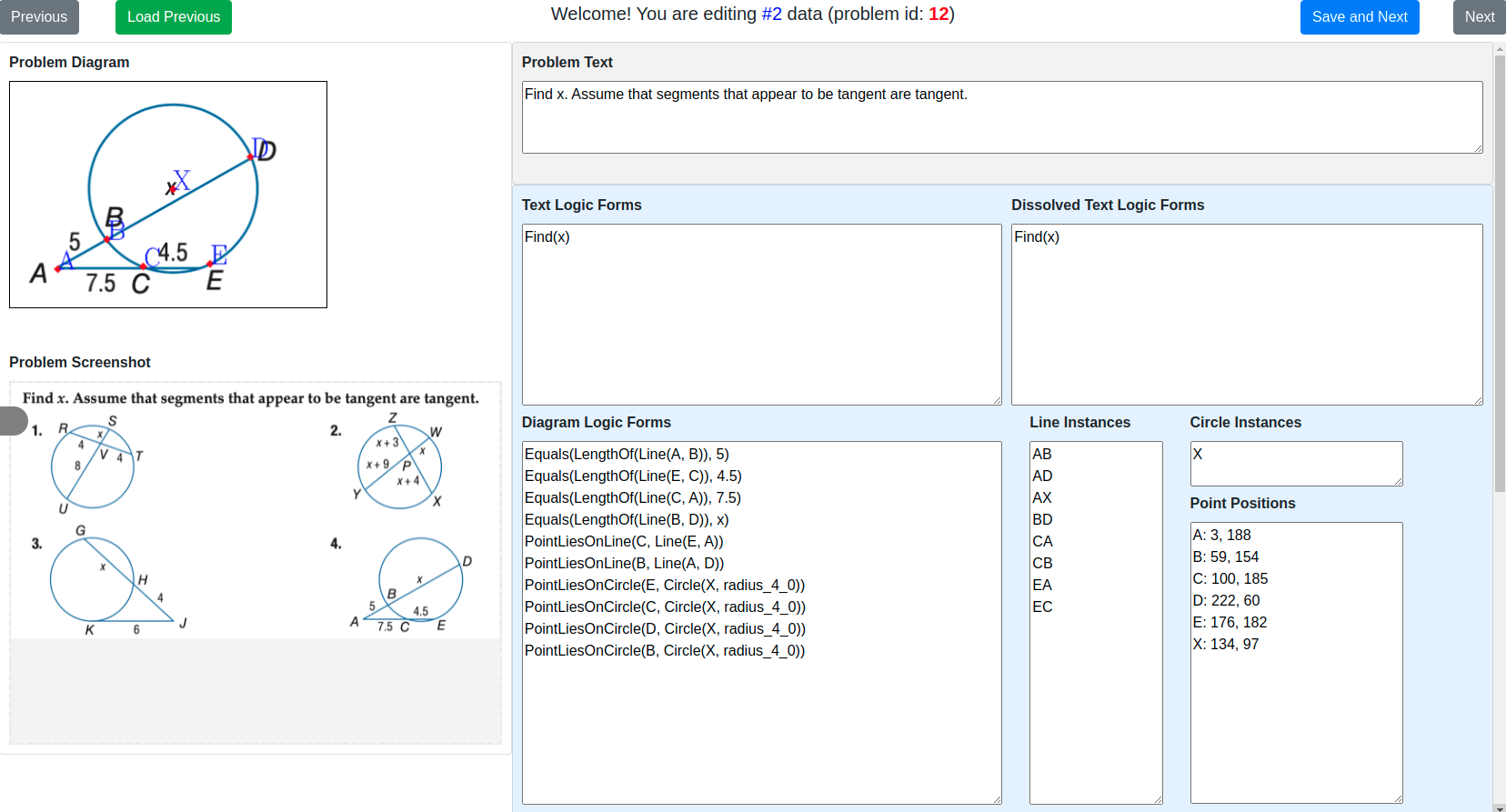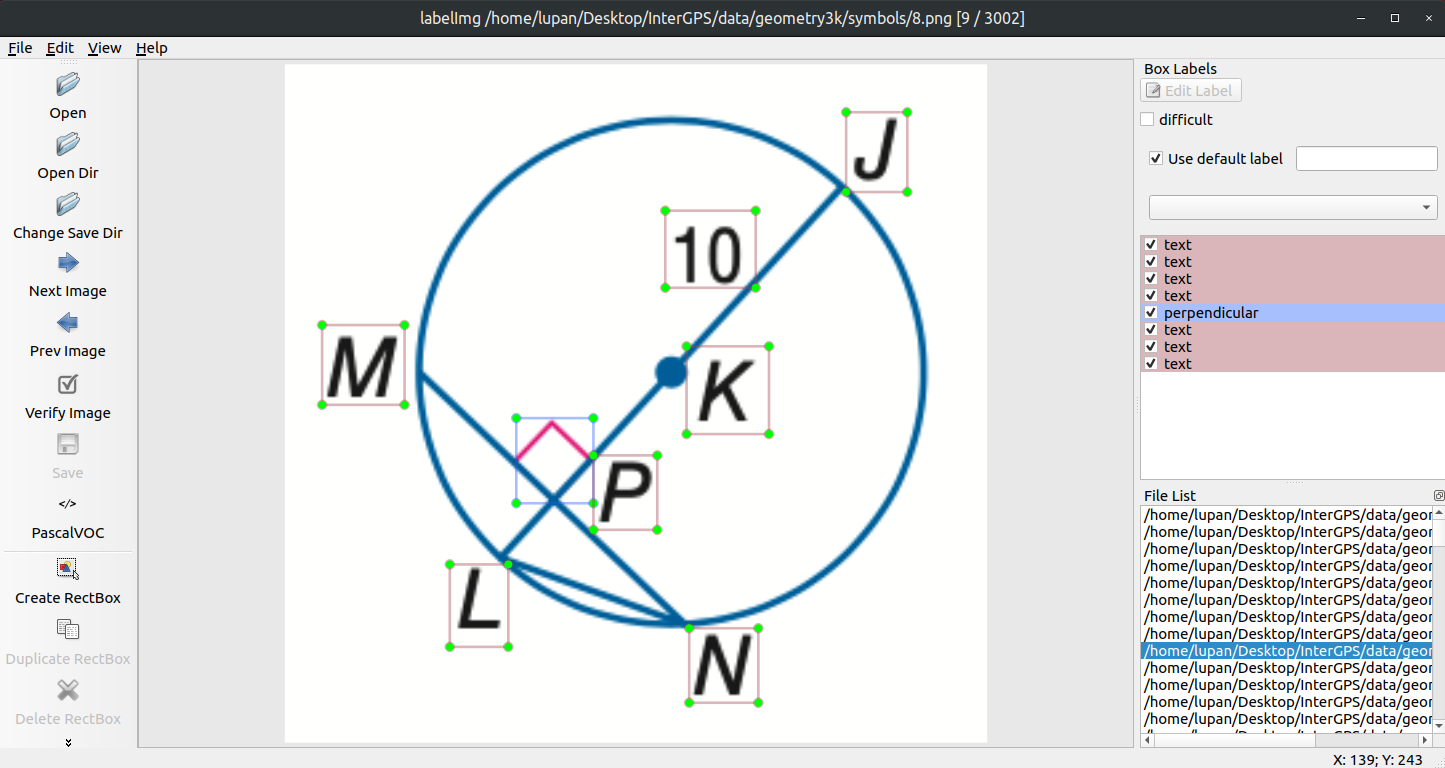Code and data for ACL 2021 Paper "Inter-GPS: Interpretable Geometry Problem Solving with Formal Language and Symbolic Reasoning".
We construct a new large-scale benchmark, Geometry3K, which consists of 3,002 geometry problems with dense annotation in formal language. We define 91 predicates and their corresponding literal templates to describe each problem. All predicates are defined in here. Four data examples in the Geometry3K dataset are shown below:
We further propose a novel geometry solving approach with formal language and symbolic reasoning, called Interpretable Geometry Problem Solver (Inter-GPS). Inter-GPS is the first geometry problem solver that achieves automatic program parsing and interpretable symbolic reasoning. Inter-GPS parses the problem text and diagram into formal language automatically via rule-based text parsing and neural object detecting, respectively. Moreover, Inter-GPS incorporates theorem knowledge as conditional rules and performs symbolic reasoning step by step.
First, unzip data files into data/geometry3k:
. data/unzip_data.shYou can alternatively visit the Google Drive link to download the Geometry dataset and unzip it.
Python 3.6+
torch 1.7.1
transformers 4.8.2
python3-pip
Install all required python dependencies:
pip3 install -r requirement.txt
Run the final symbolic solver Inter-GPS without preprocessing data by the following commands:
cd symbolic_solver
python test.py --label final --strategy finalIt applies the final search strategy (predict + low-first) with generated logic forms from the diagram parser and text parser. The solving result file and logging file will be saved in pred_results and logs, respectively.
It takes about 5 minutes for the solving process over the 601 test problems with an Intel CPU 10900K with 20 threads. If you don't have a high-performance CPU, please assign a smaller number of threads and larger searching time limit for each problem. For example:
python test.py --label final --strategy final --time_limit 200 --num_threads 4Run the symbolic solver with annotated logic forms from the dataset:
python test.py --label final-gt --strategy final --use_annotatedNote that the results could differ slightly in each individual experiment and on different computing platforms. The differences are mainly resulted from randomness of the search process, dependency versions, CPU features, and running parameters. It is highly recommended to run the solver with multiple times and report the average result of the multiple experiments.
Also, you can run the solver with other search strategies listed in Table 7 in the paper by running the following commands, receptively:
- Predict-based search strategy (predict + random) with annotated logic forms:
python test.py --label predict --strategy predict --use_annotated- Random search strategy with annotated logic forms:
python test.py --label random --strategy random --use_annotated- Low-first search strategy with annotated logic forms:
python test.py --label low-first --strategy low-first --use_annotatedAll these result files reported in the Table 7 are released in symbolic_solver/pred_results and symbolic_solver/logs, respectively.
You can obtain accuracies for different question types by running python sub_acc.py --result_file {result_json_file} . For example:
python sub_acc.py --result_file pred_results/final/logic_1612098244-predict_low-first_1.jsonParse the problem text into literals (logic forms).
cd text_parser
python text_parser.pyThe diagram parser converts a problem diagram into literals (logic forms). Only the most core running code is shown as following. If you would like to know every detail, please refer to this README file.
Unzip our detection results of text regions and symbols:
cd detection_results
unzip -d box_results box_results.zip
unzip -d ocr_results ocr_results.zipGenerate diagram logic forms by running the following command:
cd parser
python diagram_parser.py \
--data_path ../../data/geometry3k \
--ocr_path ../detection_results/ocr_results \
--box_path ../detection_results/box_results \
--output_path ../diagram_logic_forms.json- Generate template-based and random-ordered theorem sequences:
cd theorem_predict/tools
python generate_random_seqs.pyIt generates two files:
results/train/pred_seqs_train_l30_n100_template.json: 100 template-based sequences with a maximum length of 30 for each training dataresults/test/pred_seqs_test_l100_random.json: 1 random-order sequence with a maximum length of 100 for each testing data
- (Optional) Generate pseudo-optimal theorem sequences for each training data:
python check_theorem_seq.pyIt will take about 20 hours to attempt 100 tries over all training data! If you want to save time, just skip this step and use our generated data in theorem_predict/results/train/splits instead.
- (Optional) Merge 100 tries of pseudo-optimal theorem sequences into one file.
python merge_all_correct_json.py- (Optional) Train the theorem predictor from scratch:
cd theorem_predict
python train_transformer.pyIf you want save time, you could skip the step above and download checkpoint model directly:
cd theorem_predict
mkdir models
cd models
wget https://acl2021-intergps.s3.us-west-1.amazonaws.com/tp_model_best.pt- Evaluate the the theorem predictor to generate predicted theorem sequences:
cd theorem_predict
python eval_transformer.py- Generate theorem sequences for the predict-based strategy (predict + random):
cd theorem_predict/tools
python add_random_seq_to_pred_seq.pyFinally, run the symbolic solver with the Final search strategy (predict + low-first) over generated logic forms:
cd symbolic_solver
python test.py --label final_new \
--strategy final \
--text_logic_form_path ../text_parser/text_logic_forms.json \
--diagram_logic_form_path ../diagram_parser/diagram_logic_forms.json \
--predict_path ../theorem_predict/results/test/pred_seqs_test_bart_best.jsonWe release the data collection tools that probably help you extend our dataset in the future work.
The data collection tool is used to collect geometry problems and the corresponding logical forms.
cd annotation_tool/data_collection
python app.pyLabelImg is a graphical image annotation tool and label object bounding boxes in images. We use this tool to label text regions and symbols in the diagram. If you are using the Linux system, you can just run the following commands to install the tool:
cd annotation_tool/labelImg
sudo apt-get install pyqt5-dev-tools
sudo pip3 install -r requirements/requirements-linux-python3.txt
make qt5py3Run the labeling tool:
python labelImg.pyAfter running the tool, click the Open Dir button to open the data directory containing problem images, for example, InterGPS/data/geometry3k/symbols, and choose Use default label to use pre-defined labels in data/predefined_classes.txt. Note that pre-defined labels in data/predefined_classes.txt are consistent with labels in diagram_parser/detection/classes.txt.
Follow the instructions to install the LabelImg package on other systems or learn more about the usage details.
If the paper, the dataset, or the code helps you, please cite the paper in the following format :
@inproceedings{lu2021inter,
title = {Inter-GPS: Interpretable Geometry Problem Solving with Formal Language and Symbolic Reasoning},
author = {Lu, Pan and Gong, Ran and Jiang, Shibiao and Qiu, Liang and Huang, Siyuan and Liang, Xiaodan and Zhu, Song-Chun},
booktitle = {The Joint Conference of the 59th Annual Meeting of the Association for Computational Linguistics and the 11th International Joint Conference on Natural Language Processing (ACL-IJCNLP 2021)},
year = {2021}
}
If you encounter any problem, feel free to either directly contact the first authors or leave an issue in the github repo.



